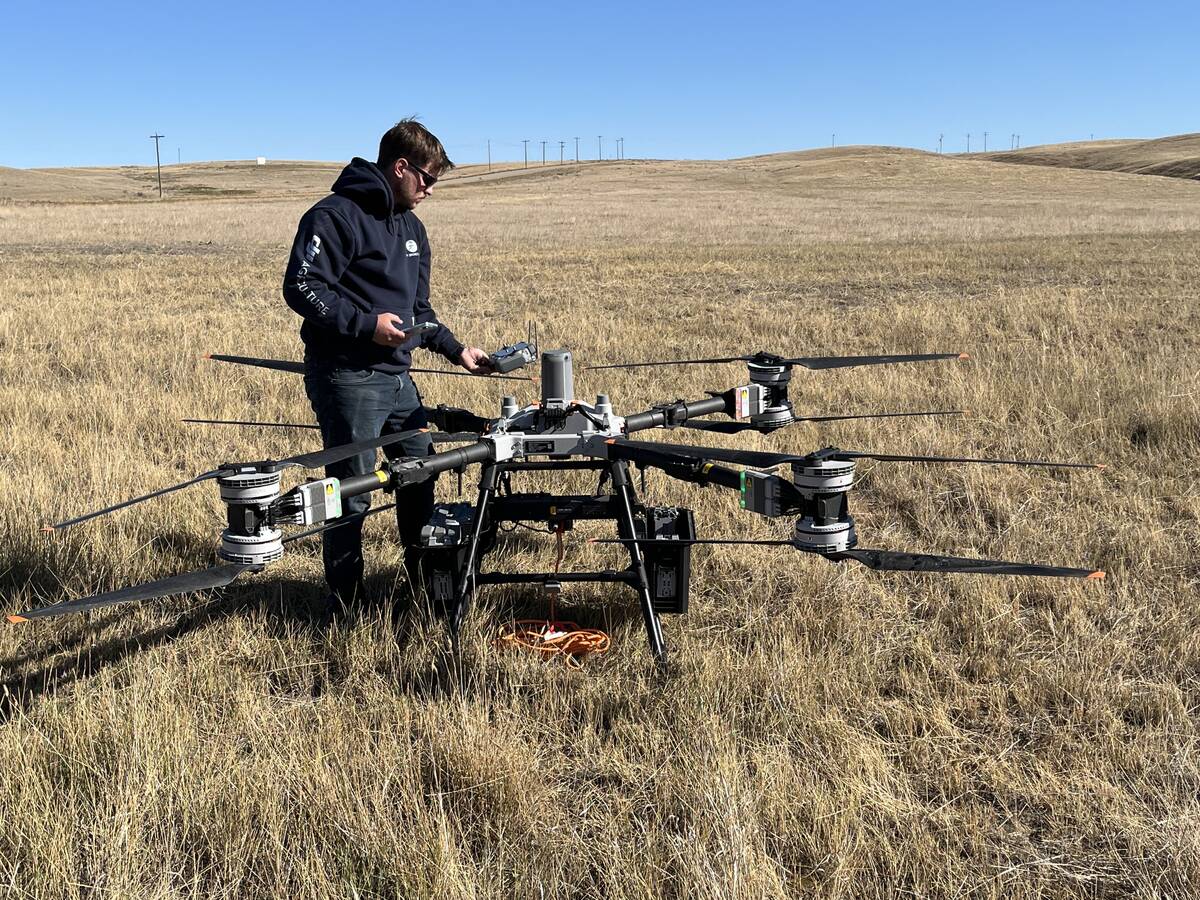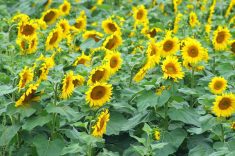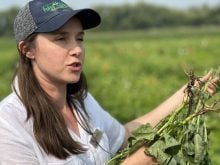Canadian farmers are expected to spend a record $23.1 billion on inputs in 2023, so they will be looking to get the most bang for their buck when it comes to fertilizer.
A recent western Canadian study could make that task a little easier in the not-too-distant future. The Resilient Rotations project is a comprehensive, five-year study that evaluated various cropping rotations. The project’s aim is to create more productive, sustainable and resilient cropping rotations on the Canadian Prairies.
The project was managed by the Western Grains Research Foundation’s Integrated Crop Agronomy Cluster, with research conducted by Agriculture and Agri-Food Canada and several universities and industry partners at seven field sites in Alberta, Saskatchewan and Manitoba.
Read Also

Farm-facing drone does the heavy lifting
Canadian distributor DJI Agriculture unveils its AGRAS T100 drone to western Canada’s producers for greater efficiencies in spraying and granular spreading in fields.
Nitrogen use efficiency was one of four key areas studied, the first phase of which wrapped up earlier this year.
Sheri Strydhorst, a former agronomy research scientist, who served as an extension specialist with the project, says high input costs and the political climate were the main reasons nitrogen use efficiency was a primary focus of the study.
“Nitrogen fertilizer is one of the most expensive input costs that farmers incur and a key determinant in grain yield. There’s also significant political interest in nitrogen fertilizer rates and the use of responsible practices such as 4R nitrogen stewardship,” she says.
“This whole nitrogen use efficiency is really key for sustainability from the productivity, the economic and environmental perspective.”
Nitrogen use efficiency
As part of the study, nitrogen use efficiency was calculated as a ratio of grain yield divided by the amount of available nitrogen in the form of soil mineral nitrogen as well as applied nitrogen fertilizer.
In a case where 30 bushels of a crop were produced with 90 pounds of available nitrogen, the nitrogen use efficiency rate would be 0.333. A canola equivalent yield was used to make the different cropping systems comparable, says Kui Liu, a research scientist based out of AAFC’s research and development centre in Swift Current, Sask., who headed the project.
Six rotation types were tested in three different regions to determine their economic viability: the northern and southern Prairies in Alberta and Saskatchewan (2018 to 2021) and Manitoba’s Red River Valley (2019 to 2022). The six rotation types were categorized as control, intensified, diversified, market driven, high risk and soil health.
Strydhorst says fertilizer rates were selected based on results of soil tests conducted to determine the amount of available nitrogen in the soil at seven test sites. The amounts varied based on the rotation and crop type.
In a case where 155 pounds of nitrogen were required and there were 70 pounds of available nitrogen in the soil, that meant 85 pounds were applied in the form of mineral nitrogen fertilizer.
Liu says soil testing was conducted to a depth of 60 centimetres rather than the 15 cm used on most farms. That helped provide a more precise measurement of nitrogen in the soil at the depth most plant roots will reach. Testing was conducted the previous fall when soil had cooled because there wasn’t enough time to do it in the spring.
The exception to applied fertilizer rates was in the case of the market-driven rotations, in which 1.2 times the recommended rate of fertilizer was used. Strydhorst says this reflected that farmers sometimes try to achieve maximum yield potential even though there may be higher associated costs.
Northern Prairies
The control rotation at the two Alberta locations in Beaverlodge and Lacombe included wheat, pea, wheat and canola, while the intensified system was comprised of wheat, canola, wheat and canola. The diversified rotation was pea, winter wheat, faba bean and canola.
A market-driven rotation consisted of canola, malt barley, canola and canola, while the high-risk rotation featured flax, soybean, durum and canola. A soil health rotation was comprised of forage pea for green manure, winter wheat, faba bean and canola.
At the two Saskatchewan test sites in Melfort and Scott, the control rotation included canola, wheat, pea and wheat, while the intensified rotation featured canola, wheat, canola and wheat. A diversified rotation featured pea, winter wheat, faba bean and canola and a market-driven rotation was comprised of oat, canola, wheat and canola in Melfort and canola, canola, green pea and canola in Scott.
The high-risk rotation at the two Saskatchewan sites included flax, soybean, durum and canola and the soil health rotation featured forage pea for green manure, winter wheat, faba bean and canola.
The diversified rotations in the northern Prairies consistently had some of the highest nitrogen use efficiencies in the region. Strydhorst attributes that to the presence of pulse crops and winter wheat in those rotations.
“It definitely wasn’t a surprise,” she says.
“If we look at the diversified rotations at the Alberta sites, it was pea, winter wheat, faba bean and canola. Of those four crops, pea and faba bean are nitrogen fixing crops and the winter wheat is taking up late fall nitrogen in the system.
“On those pulse crop years when you have the pea and faba bean, no mineral nitrogen fertilizer needs to be added.”
Another factor in the success of the diversified rotations in the northern Prairies, according to Liu, is that the chosen crops spur soil microbe activity, which in turn releases more nitrogen from the soil.
The soil health rotations in Alberta and Saskatchewan all had relatively low nitrogen efficiency rates. Strydhorst says that was largely because they produced harvestable yields in only three of four years with no harvestable product produced during the forage pea/green manure year.
“You’re producing nitrogen for the system but you’re not producing a harvestable product. The nitrogen (production) doesn’t offset the loss of the harvested grain.”
Results at the two Saskatchewan test sites were markedly different, with those in Melfort far less positive than in Scott. Liu says that was because seeding at that site in 2020 occurred about a month later than at the other sites because of the COVID-19 pandemic, and yields there were only 60 or 70 per cent of normal.
Strydhorst says results in the northern Prairie region highlight the important role pulse crops play in a rotation.
“It just highlights that pulse crops contribute so much to nitrogen use efficiency in the system. To have more verifiable documentation of that (is important). Pulse crops can be a headache to grow so here’s one more piece of supporting evidence to show the benefits of those in the system.”
Southern Prairies
The southern Prairies region included test sites in Lethbridge, Alta., and Swift Current, Sask.
The four-year control rotation used there consisted of fallow, followed by durum, malt barley and finally durum. The intensified rotation consisted of lentil, durum, chickpea and durum, while the diversified rotation was comprised of lentil, canola, pea and durum.
The market-driven and high-risk rotations varied slightly between the two sites. The market-driven rotation in Swift Current included flax, wheat, lentil and feed barley while its counterpart in Lethbridge contained canola, wheat, wheat and malt barley. The high-risk rotation featured soybean, canary seed, faba bean and durum in Swift Current with corn substituted for canary seed in Lethbridge. The soil health rotation included forage pea for green manure, barley and pea as an intercrop, another intercrop of faba bean and barley and durum.
The intensified and diversified rotations in the southern Prairies had the highest nitrogen use efficiency in the region. Strydhorst says those performances can again be largely attributed to the presence of pulse crops.
“When you look at those rotations, they have the lentil and the chickpea or the lentil or the pea, so a pulse crop two out of the four years,” she says.
“That means not having to add a mineral nitrogen fertilizer in 50 per cent of the years of that rotation. That, automatically, and coupled with yields, gives you that improved nitrogen use efficiency in those two treatments.”
As was the case in the northern Prairies, the soil health rotation in this region did not have a high nitrogen use efficiency because of its low yield and the fact it produced a harvestable product in only three of four years.
Strydhorst says an encouraging sign in the southern Prairies is that many farmers in the region regularly incorporate pulse crops in their rotations.
“Farmers often have that pulse crop, durum, pulse crop, durum rotation, which has that high nitrogen use efficiency. That’s a very common practice. This is just kind of a verification of that activity which they are already doing, which is nice to see,” she adds.
Red River Valley
The Red River Valley test site, near the town of Carman, Man., tested a control rotation of wheat, soybean, wheat and canola and an intensified rotation of soybean, wheat, soybean and canola. In addition, a diversified rotation featured canola, winter wheat, soybean and canola, while a market-driven rotation was comprised of corn, corn, oat and canola.
A high-risk rotation included corn, dry bean, canola and sunflower, while a soil health rotation featured green manure, fall rye, corn-soybean and canola-pea intercrops.
Unlike the two other regions, where the diversified and market-driven rotations were clear winners, the high-risk rotation had the highest nitrogen use efficiency in the Red River Valley. Strydhorst says that can be chalked up to high corn and sunflower yields in the rotation for two of the four years.
“I think it really highlights that high nitrogen use efficiency is coupled with high grain yields. On the flip side, low nitrogen use efficiency is often coupled with low grain yields.”

Surprisingly, the diversified rotation in the Red River Valley didn’t perform well in terms of its nitrogen use efficiency. Liu says that was mostly attributable to an infestation of flea beetles in one of the years canola was grown, which significantly lowered the yield.
As was the case in the other two regions, the soil health rotation did not have a high nitrogen use efficiency in the Red River Valley.
Strydhorst says the take-home message from the Carman results is “high yields equal high nitrogen use efficiency and low yield equals low nitrogen use efficiency.”
Moving forward
Liu and his team are waiting for word on additional funding to continue a second, five-year phase of the study. He says further study is needed to provide a more precise picture of the effects different rotations can have on crop productivity, sustainability and resilience.
“In this crop system study, the first cycle of rotations is a transition period. It’s more affected by your historical cropping system rather than your testing cropping system,” he says.
“During this transition period, we really cannot assess the rotation effect fairly, so we want to extend this study for another crop rotation cycle. That way we can assess the true rotation effects so we can optimize the cropping system.
“The second reason is some variables such as your soil health cannot be assessed over a short period of time. You need a longer term. It’s the same thing with resilience. We need more environmental scenarios to assess the cropping system response to stress and then to assess the resiliency of that cropping system.”
Liu says most of the parameters in the proposed second phase of the study would remain the same, but researchers would also like to gather actual greenhouse gas emissions generated in the field. In the first phase, that data was gathered using models and projections.
















